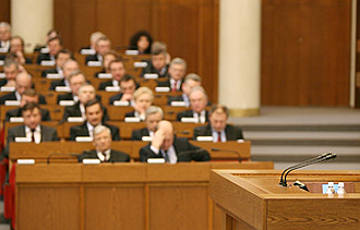Leu Marholin: The Government's Forecasts Are Completely Off the Wall
8- 5.08.2016, 8:18
- 9,260

The Belarusian government is trying to put the blame for its failures on external factors.
The forecast of socio-economic development has been drawn up on the basis of oil cost $45 per barrel, the growth of Russia's economy at the level of 101% and the exchange rate of Russian ruble against the US dollar at 70 rubles, and Belarusian budget for 2017 is based on a conservative approach: the average annual price of oil - $35 per barrel with a further contraction of the Russian economy (99% compared to 2016) and a course of 75 Russian rubles against the US dollar.
Such figures were called by Prime Minister Andrei Kabyakau at the Council of Ministers Presidium meeting on August 2, Minsk. It considered draft projects of the socio-economic development for 2017 and parameters of the main indicators for 2018 - 2019, the main directions of the monetary policy of the Republic of Belarus and the national budget for 2017. We cannot but pay attention that basic indicators two documents are grounded on clash with each other.
Why did it happen? The information service of EuroBelarus together with economist Leu Marholin tried to find out a source of the conflict.
- How could it happen that the two most important financial documents - for a five-year period and for a year - are based on a completely different numbers?
- Only their developers could give an answer. I believe that there are two factors. First - time intervals: one document was developed earlier; the second point - the budget was developed by the Ministry of Finance and Main provisions of the socio-economic development - by the Ministry of Economy.
- Is the right hand not aware of what the left is doing?
- Well, yes. To set in train the development of core financial documents, to finalize them, the Council of Ministers should adopt some basic indicators which all ministries and departments could use. And here, apparently, each ministry had its own forecasts. Either the government has provided the following figures in different time.
- The budget for 2015 envisages GDP growth by 1.5%, income of the population - by 1.2%, exports of goods and services - by 3.6%, direct foreign investments on a net basis should equal to $1.4 billion, inflation - 9%. Can the planned economy growth for 2017 be taken seriously?
- I think, no. Even the ministries which develop these forecasts do not believe in it. We have repeatedly witnessed how ministries and the government developed some forecasts followed by Lukashenka's dreadful voice: it's not enough! And then everything had turned into more rosy colours.
Developers themselves do not really believe in forecasts they make, besides, they have realized there will be no punishment for mistakes. Earlier, in the years of economic growth, they were afraid to make mistakes, now all is justified by the crisis situation in Russia and external factors. I guess, all government's forecasts are completely off the wall.
- Do unbiased indicators for the first half of 2016 give any reason for at least the output to zero?
- One of Belarusian economists noticed: in our case, even a slight increase can't be considered a signal that we have reached the bottom. The Belarusian economy stagnates, it means we can face first 1% growth, than decline. Since the indicators do not go beyond the statistical error, you can draw any figure. There should be a ground for possible growth: whether comprehensive overhauls or fundamental changes in Russia, which is the largest market for Belarusian products. Nothing of it is observed. Therefore, I would keep the economy growth issue open.
- Since August 17 the National Bank has decided to reduce the refinancing rate from 20 to 18 percent per annum and the interest rate on standing and bilateral operations of the National Bank on support of the current liquidity of banks from 25 to 23 percent per annum. Is such decision reliable?
- I think, yes. The National Bank manages to stem inflation at quite acceptable limits. The reduction of discount rate is based on reduction of inflation. The National Bank hopes that as soon as the rate is more or less acceptable, companies will take new loans. It will promote investments and rapid growth.
The discount rate and access to credits is an essential factor, but is not of the highest priority. To run for a loan you need to produce competitive products at an affordable price and find markets. If it does not exist, no one will take loans, no matter how low the interest is. The authorities do not understand it; they perhaps persuaded Lukashenka that it was time to stop inflation-linked pumping up of the economy. But again, the reduction of the discount rate is not a panacea, and I strongly doubt that these actions lead to significant results.









